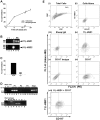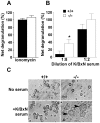Mast cells express 11β-hydroxysteroid dehydrogenase type 1: a role in restraining mast cell degranulation
- PMID: 23349944
- PMCID: PMC3548897
- DOI: 10.1371/journal.pone.0054640
Mast cells express 11β-hydroxysteroid dehydrogenase type 1: a role in restraining mast cell degranulation
Abstract
Mast cells are key initiators of allergic, anaphylactic and inflammatory reactions, producing mediators that affect vascular permeability, angiogenesis and fibrosis. Glucocorticoid pharmacotherapy reduces mast cell number, maturation and activation but effects at physiological levels are unknown. Within cells, glucocorticoid concentration is modulated by the 11β-hydroxysteroid dehydrogenases (11β-HSDs). Here we show expression and activity of 11β-HSD1, but not 11β-HSD2, in mouse mast cells with 11β-HSD activity only in the keto-reductase direction, regenerating active glucocorticoids (cortisol, corticosterone) from inert substrates (cortisone, 11-dehydrocorticosterone). Mast cells from 11β-HSD1-deficient mice show ultrastructural evidence of increased activation, including piecemeal degranulation and have a reduced threshold for IgG immune complex-induced mast cell degranulation. Consistent with reduced intracellular glucocorticoid action in mast cells, levels of carboxypeptidase A3 mRNA, a glucocorticoid-inducible mast cell-specific transcript, are lower in peritoneal cells from 11β-HSD1-deficient than control mice. These findings suggest that 11β-HSD1-generated glucocorticoids may tonically restrain mast cell degranulation, potentially influencing allergic, anaphylactic and inflammatory responses.
Conflict of interest statement
Figures





References
-
- Kinet JP (2007) The essential role of mast cells in orchestrating inflammation. Immunol Rev 217: 5–7. - PubMed
-
- Laitinen LA, Laitinen A, Haahtela T (1993) Airway mucosal inflammation even in patients with newly diagnosed asthma. Am Rev Respir Dis 147: 697–704. - PubMed
-
- Pesci A, Foresi A, Bertorelli G, Chetta A, Olivieri D (1993) Histochemical characteristics and degranulation of mast cells in epithelium and lamina propria of bronchial biopsies from asthmatic and normal subjects. Am Rev Respir Dis 147: 684–689. - PubMed
Publication types
MeSH terms
Substances
Grants and funding
LinkOut - more resources
Full Text Sources
Other Literature Sources
Molecular Biology Databases

